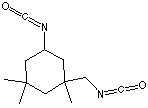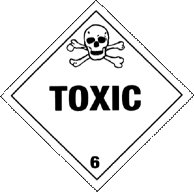Isophorone diisocyanate
- 3-Isocyanatomethyl-3,5,5-trimethylcyclohexyl isocyanate
- 1,1,5,5-Tetramethylcyclohexane-a-1,3-diisocyanate
- 5-Isocyanato-1-isocyanatomethyl-1,3,3-trimethylcoclohexane

Isophorone diisocyanate | |
| |
| Formula | C12H18N2O2 |
| Structure |  |
| Description | Colorless to slightly yellow liquid with a pungent odor. |
| Uses | Yields polyurethanes with high stability, resistance to light discoloration, and chemical resistance. |
| Registry Numbers and Inventories. | |
| CAS | 4098-71-9 |
| EC (EINECS/ELINCS) | 223-861-6 |
| EC Index Number | 615-008-00-5 |
| EC Class | Toxic; Irritant; Sensitising; Dangerous for the Environment |
| EC Risk Phrase | R 23 36/37/38 42/43 51/53 |
| EC Safety Phrase | S 26 28 38 45 61 |
| RTECS | NQ9370000 |
| RTECS class | Reproductive Effector |
| UN (DOT) | 2290 |
| Beilstein/Gmelin | 2726467 |
| Beilstein Reference | 6-13 |
| Swiss Giftliste 1 | G-6847 |
| Canada DSL/NDSL | DSL |
| US TSCA | Listed |
| Austrailia AICS | Listed |
| New Zealand | Listed |
| Japan ENCS (MITI) | Listed |
| Korea ECL | Listed |
| Properties. | |
| Formula | C12H18N2O2 |
| Formula mass | 222.29 |
| Melting point, °C | -60 |
| Boiling point, °C | 158 |
| Vapor pressure, mmHg | 0.0003 |
| Saturation Concentration | 0.40-0.53 ppm at 20 C (calculated) |
| Evaporization number | Probably very low |
| Density | 1.049 g/cm3 (20 C) |
| Solubility in water | Reacts |
| Refractive index | 1.482 (25 C) |
| Hazards and Protection. | |
| Storage | Keep in a cool, dry, dark location in a tightly sealed container or cylinder. Keep away from incompatible materials, ignition sources and untrained individuals. Secure and label area. Protect containers/cylinders from physical damage. |
| WHMIS | D1A D2A D2B |
| Handling | All chemicals should be considered hazardous. Avoid direct physical contact. Use appropriate, approved safety equipment. Untrained individuals should not handle this chemical or its container. Handling should occur in a chemical fume hood. |
| Protection | Wear appropriate protective gloves, clothing and goggles. |
| Respirators | Wear positive pressure self-contained breathing apparatus (SCBA). |
| Small spills/leaks | Keep sparks, flames, and other sources of ignition away. Keep material out of water sources and sewers. Build dikes to contain flow as necessary. Do not use water. |
| Disposal code | 9 |
| Stability | No data. |
| Incompatibilities | Reacts with all substances containing active hydrogen atoms such as water, alcohols, phenols, amines, mercaptans, amides, urethanes and ureas. |
| Fire. | ||||
| Flash Point,°C | 155 | |||
| Autoignition, °C | 430 | |||
| Upper exp. limit, % | 4.5 | |||
| Lower exp. limit, % | 0.7 | |||
| Fire fighting | Keep unnecessary people away; isolate hazard area and deny entry. Stay upwind; keep out of low areas. Ventilate closed spaces before entering them. Wear positive pressure breathing apparatus and special protective clothing. Remove and isolate contaminated clothing at the site.Small fires: dry chemical, carbon dioxide, water spray or foam. Large fires: water spray, fog or foam. Move container from fire area if you can do so without risk. Fight fire from maximum distance. Dike fire control water for later disposal; do not scatter the material. | |||
| Fire potential | Combustible material: may burn but does not ignite readily. | |||
| Hazards | When heated to decomposition, it emits toxic fumes of nitrogen oxides. | |||
| Combustion products | Fire will produce irritating, corrosive and/or toxic gases. | |||
| NFPA | Health | 2 | ||
| Flammability | 1 | |||
| Reactivity | 1 | |||
| Special | W | |||
| Health. | |
| Exposure limit(s) | TLV: 0.005 ppm; 0.045 mg/m3 (skin) (ACGIH 1991-1992). NIOSH REL: TWA 0.005 ppm (0.045 mg/m3) ST 0.02 ppm (0.180 mg/m3) skin |
| Poison_Class | 2 |
| Exposure effects | No data were available to assess the teratogenic potential of this agent. <br>No data were available to assess the potential effects of exposure to this agent during pregnancy or lactation. |
| Ingestion | Gastrointestinal tract irritation could potentially occur. |
| Inhalation | Respiratory tract irritation may occur. Pulmonary sensitization with bronchospasm on re-exposure is possible. Released oxides of nitrogen could produce severe irritation or pulmonary edema. |
| Skin | Direct contact produces skin irritation. Dermal hypersensitivity reactions may be seen on re-exposure. |
| Eyes | Irritation may result from direct eye contact. Exposure to vapors may produce irritation to the mucosa of the nose and throat. |
First aid | |
| Ingestion | Do not induce vomiting - consider after ingestion of a potentially life-threatening amount of poison if it can be performed soon after ingestion (generally within 1 hour). Activated charcoal: administer charcoal as a slurry (240 ml water/30 g charcoal). Usual dose: 25 to 100 g in adults/adolescents. Observe patients with ingestion carefully for the possible development of esophageal or gastrointestinal tract irritation or burns. If signs or symptoms of esophageal irritation or burns are present, consider endoscopy to determine the extent of injury. |
| Inhalation | Move patient to fresh air. Monitor for respiratory distress. If cough or difficulty breathing develops, evaluate for respiratory tract irritation, bronchitis, or pneumonitis. Administer oxygen and assist ventilation as required. Treat bronchospasm with beta2 agonist and corticosteroid aerosols. |
| Skin | Remove contaminated clothing and wash exposed area thoroughly with soap and water. A physician should examine the area if irritation or pain persists. Systemic antihistamine or corticosteroid therapy may be required for hypersensitivity reactions. |
| Eyes | Irrigate exposed eyes with copious amounts of tepid water for at least 15 minutes. If irritation, pain, swelling, lacrimation, or photophobia persist, the patient should be seen in a health care facility. As severe ocular injury may occur with direct eye contact, consider early ophthalmologic consultation. |
| Transport. | ||
| UN number | 2290 |  |
| Response guide | 156 | |
| Hazard class | 6.1 | |
| Packing Group | III | |
| USCG CHRIS Code | IPD | |
| USCG Compatatibility Group | 12 Isocyanates | |
| HS Code | 2929 10 90 | |
| Std. Transport # | 4925107 | |
| IMO Chemical Code | 17 | |
| IMO Pollution Category | B | |
| IMO Hazard code | S/P | |